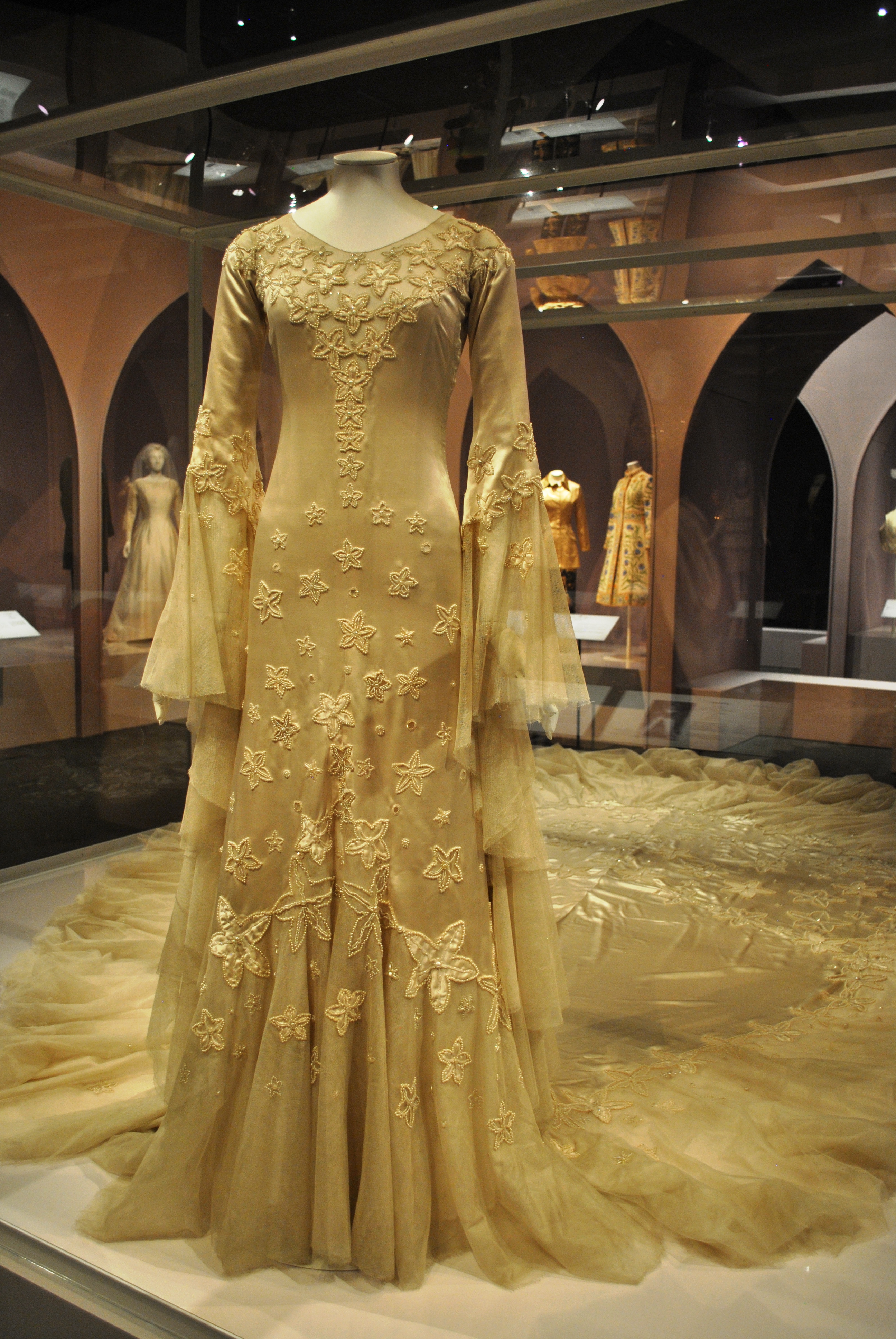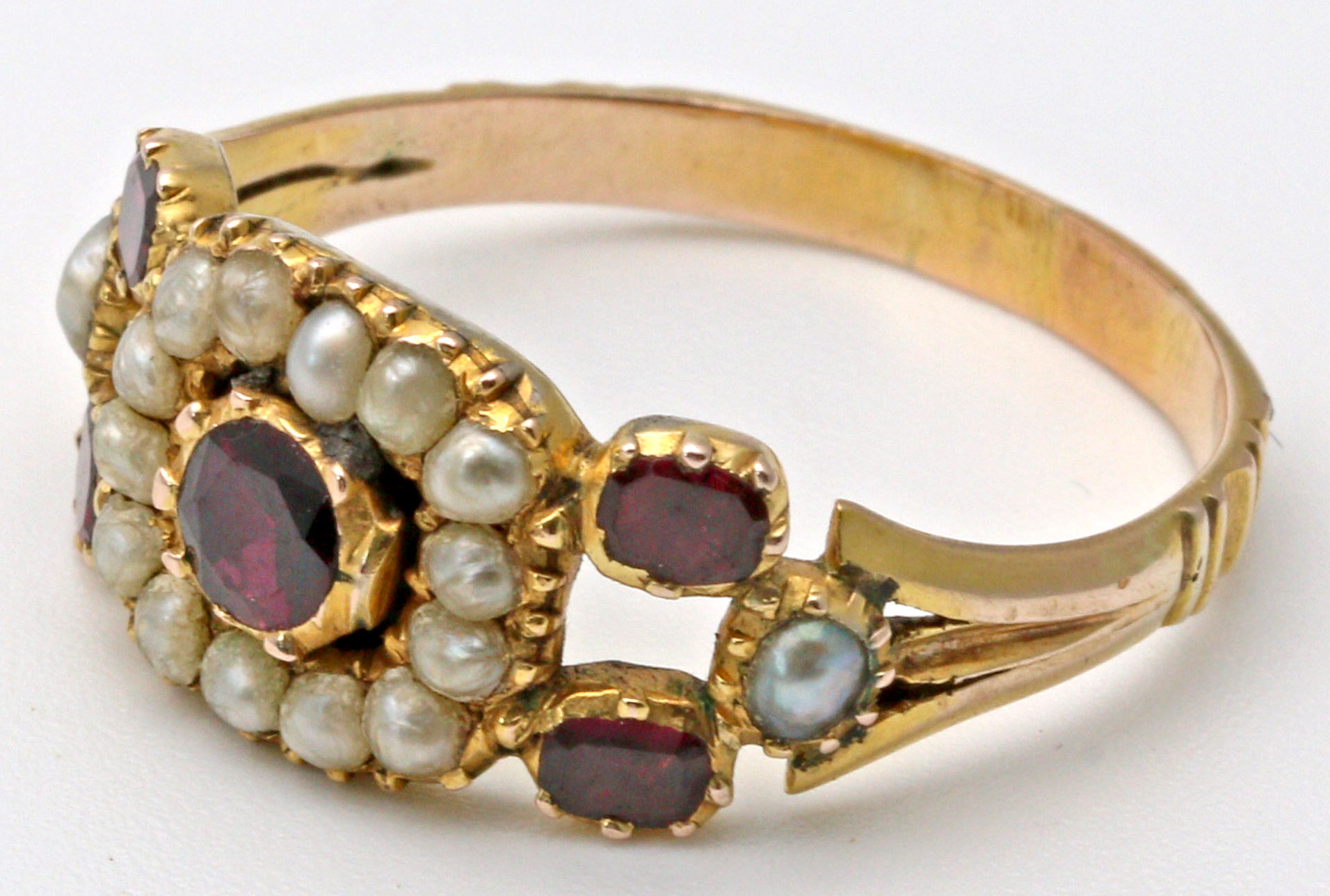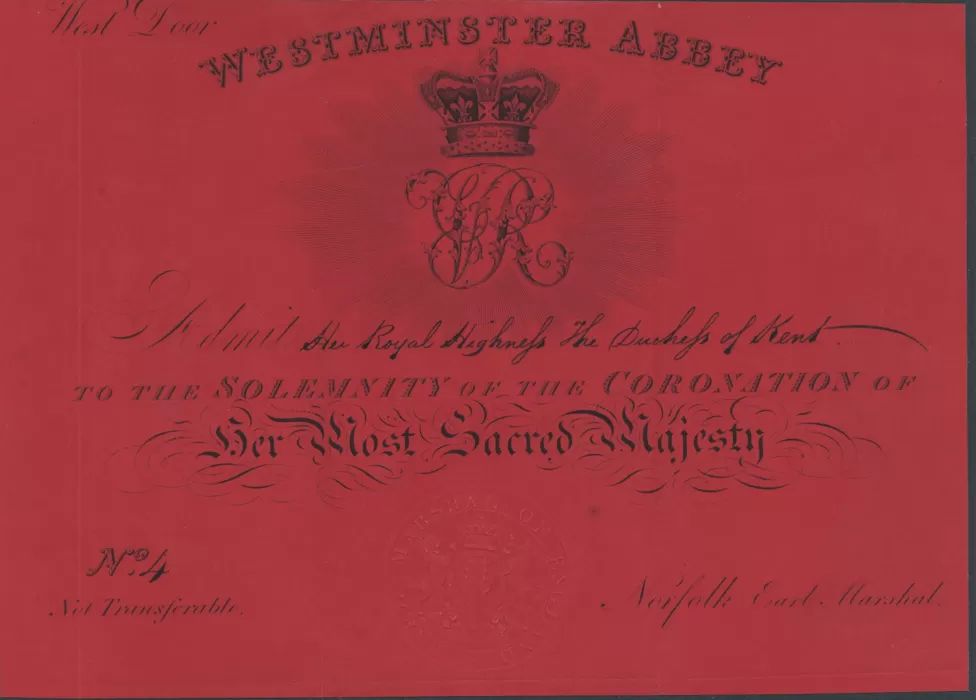|
Coronation Gown Of Queen Elizabeth II
Queen Elizabeth II's coronation took place on 2 June 1953. Ordered in October 1952, her gown took eight months of research, design, workmanship, and intricate embroidery to complete. It featured the floral emblems of the countries of the United Kingdom and those of the other states within the Commonwealth of Nations, including the English Tudor rose, Scots thistle, Welsh leek, Irish shamrock, Canadian maple leaf, Australian wattle, New Zealand silver fern, South African protea, Indian lotus flower for India, the Lotus flower of Ceylon, and Pakistan's wheat, cotton, and jute. The gown, like Elizabeth's wedding dress and other notable royal dresses of this period, was designed by Norman Hartnell. It was Elizabeth's wish that the coronation dress should be made of satin, like her wedding dress, with accentuation of regal elegance, but with no undue emphasis on shape. The gown now forms part of the Royal Collection. After the coronation, the Queen wore the dress on sever ... [...More Info...] [...Related Items...] OR: [Wikipedia] [Google] [Baidu] |
Norman Hartnell
Sir Norman Bishop Hartnell (12 June 1901 – 8 June 1979) was a leading British fashion designer, best known for his work for the ladies of the British royal family, royal family. Hartnell gained the Royal Warrant of Appointment (United Kingdom), Royal Warrant as Dressmaker to Queen Elizabeth The Queen Mother, Queen Elizabeth (later the Queen Mother) in 1940, and Royal Warrant as Dressmaker to Elizabeth II, Queen Elizabeth II in 1957. Princess Beatrice also wore a dress designed for Queen Elizabeth II by Hartnell for Wedding of Princess Beatrice and Edoardo Mapelli Mozzi, her wedding in 2020. Early life and career Hartnell was born in Streatham, southwest London. His parents were then publicans and owners of the Crown & Sceptre, at the top of Streatham Hill. Educated at Mill Hill School, Hartnell became an undergraduate at Magdalene College, Cambridge and read Modern Languages. Hartnell's main interests were in performing in, and designing for, productions at Cambridge Univers ... [...More Info...] [...Related Items...] OR: [Wikipedia] [Google] [Baidu] |
Jute
Jute ( ) is a long, rough, shiny bast fibre that can be Spinning (textiles), spun into coarse, strong threads. It is produced from flowering plants in the genus ''Corchorus'', of the mallow family Malvaceae. The primary source of the fiber is ''Corchorus olitorius'', but such fiber is considered inferior to that derived from ''Corchorus capsularis''. Jute fibers, composed primarily of cellulose and lignin, are collected from bast (the phloem of the plant, sometimes called the "skin"). The industrial term for jute fiber is ''raw jute''. The fibers are off-white to brown and range from long. In Bangladesh, jute is called the "golden fiber" for its color and monetary value. The bulk of the jute trade is centered in South Asia, with India and Bangladesh as the primary producers. The majority of jute is used for durable and sustainable packaging, such as Gunny sack, burlap sacks. Its production and usage declined as Disposable product, disposable plastic packaging became common, b ... [...More Info...] [...Related Items...] OR: [Wikipedia] [Google] [Baidu] |
Pearls
A pearl is a hard, glistening object produced within the soft tissue (specifically the mantle (mollusc), mantle) of a living Exoskeleton, shelled mollusk or another animal, such as fossil conulariids. Just like the shell of a mollusk, a pearl is composed of calcium carbonate (mainly aragonite or a mixture of aragonite and calcite) in minute crystalline form, which has deposited in concentric layers. More commercially valuable pearls are perfectly round and smooth, but many other shapes, known as baroque pearls, can occur. The finest quality of natural pearls have been highly valued as gemstones and objects of beauty for many centuries. Because of this, ''pearl'' has become a metaphor for something rare, fine, admirable, and valuable. The most valuable pearls occur spontaneously in the wild but are extremely rare. These wild pearls are referred to as ''natural'' pearls. ''Cultured'' or ''farmed'' pearls from Pinctada, pearl oysters and freshwater mussels make up the majority o ... [...More Info...] [...Related Items...] OR: [Wikipedia] [Google] [Baidu] |
Arum Lilies
''Zantedeschia'' () is a genus of eight species of herbaceous, perennial, flowering plants in the aroid family, Araceae, native to southern Africa (from South Africa northeast to Malawi). The genus has been introduced, in some form, on every continent other than Antarctica. Common names include arum lily for ''Z. aethiopica'', calla and calla lily for ''Z. elliottiana'' and ''Z. rehmannii''. However, members of this genus are not true lilies (which belong to the family Liliaceae), and the genera ''Arum'' and ''Calla'', although related, are distinct from ''Zantedeschia'', despite visual similarities. The colourful flowers and leaves, of both species and cultivars, are greatly valued and commonly grown as ornamental and garden plants. Description ''Zantedeschia'' species are rhizomatous, herbaceous, perennial plants with some species, e. g., ''Zantedeschia aethiopica'', growing to 1.2 m tall, while ''Zantedeschia rehmannii'' does not exceed 60 cm in height, growing in clum ... [...More Info...] [...Related Items...] OR: [Wikipedia] [Google] [Baidu] |
Madonna Lily
''Lilium candidum'', the Madonna lily or white lily, is a plant in the true lily family. It is native to the Balkans and Middle East, and naturalized in other parts of Europe, including France, Italy, and Ukraine, and in North Africa, the Canary Islands, Mexico, and other regions. It has been cultivated since antiquity, for at least 3,000 years, and has great symbolic value since then for many cultures. It is susceptible to several virus diseases common to lilies, and especially to ''Botrytis'' fungus. One technique to avoid problems with viruses is to grow plants from seed instead of bulblets. Description It forms bulbs at ground level, and, unlike other lilies, grows a basal rosette of leaves during winter, which die the following summer. A leafy floral stem, which generally grows tall, but exceptionally tall, emerges in late spring and bears several sweetly and very fragrant flowers in summer. The flowers are pure white and tinted yellow in their throats. In culture Mado ... [...More Info...] [...Related Items...] OR: [Wikipedia] [Google] [Baidu] |
Crinoline
A crinoline is a stiff or structured petticoat designed to hold out a skirt, popular at various times since the mid-19th century. Originally, crinoline described a stiff fabric made of horsehair ("crin") and cotton or linen which was used to make underskirts and as a dress lining. The term crin or crinoline continues to be applied to a nylon stiffening tape used for interfacing and lining hemlines in the 21st century. By the 1850s the term crinoline was more usually applied to the fashionable silhouette provided by horsehair petticoats, and to the hoop skirts that replaced them in the mid-1850s. In form and function these hoop skirts were similar to the 16th- and 17th-century farthingale and to 18th-century panniers, in that they too enabled skirts to spread even wider and more fully. The steel-hooped cage crinoline, first patented in April 1856 by R.C. Milliet in Paris, and by their agent in Britain a few months later, became extremely popular. Steel cage crinolines were ... [...More Info...] [...Related Items...] OR: [Wikipedia] [Google] [Baidu] |
Sheath Gown
In fashion, a sheath dress is a fitted, straight cut dress, often nipped at the waistline with no waist seam. When constructing the dress, the bodice and skirt are joined together by combining the skirt darts into one dart: this aligns the skirt darts with the bodice waist dart. The dress emphasizes the waist as its skirt portion is fitted. While the sheath dress can come in many patterns and lengths, it often is worn with short sleeves and reaches knee length. Ancient Egypt Originating in the ancient world, the sheath dress is commonly seen in Egyptian art. Presented as slender and youthful, artistic renditions of the women in the garment were common prior to the New Kingdom. Although there was no archeological evidence of a sheath dress among the elite, women and deities are shown wearing the garment in tomb drawings. The garment was often presented with a seam under the breast and with beads. Ancient depictions of elite women showed the dress paired with the tripartite wig an ... [...More Info...] [...Related Items...] OR: [Wikipedia] [Google] [Baidu] |
Coronation Of Queen Victoria
The coronation of Queen Victoria, Victoria as queen of the United Kingdom took place on Thursday, 28 June 1838, just over a year after she succeeded to the throne of the United Kingdom at the age of 18. The ceremony was held in Westminster Abbey after a public procession through the streets from Buckingham Palace, to which the Queen returned later as part of a second procession. Planning for the coronation, led by the prime minister, Lord Melbourne, began at Cabinet of the United Kingdom, Cabinet level in March 1838. In the face of various objections from numerous parties, the Cabinet announced on Saturday, 7 April, that the coronation would be at the end of the Legislative session, parliamentary session in June. It was budgeted at £70,000, which was more than double the cost of the "cut-price" Coronation of William IV and Adelaide, 1831 coronation, but considerably less than the £240,000 spent when George IV was crowned in July 1821. A key element of the plan was presentation ... [...More Info...] [...Related Items...] OR: [Wikipedia] [Google] [Baidu] |
Queen Victoria
Victoria (Alexandrina Victoria; 24 May 1819 – 22 January 1901) was Queen of the United Kingdom of Great Britain and Ireland from 20 June 1837 until Death and state funeral of Queen Victoria, her death in January 1901. Her reign of 63 years and 216 days, which was List of monarchs in Britain by length of reign, longer than those of any of her predecessors, constituted the Victorian era. It was a period of industrial, political, scientific, and military change within the United Kingdom of Great Britain and Ireland, United Kingdom, and was marked by a great expansion of the British Empire. In 1876, the British parliament voted to grant her the additional title of Empress of India. Victoria was the daughter of Prince Edward, Duke of Kent and Strathearn (the fourth son of King George III), and Princess Victoria of Saxe-Coburg-Saalfeld. After the deaths of her father and grandfather in 1820, she was Kensington System, raised under close supervision by her mother and her Comptrol ... [...More Info...] [...Related Items...] OR: [Wikipedia] [Google] [Baidu] |
Dominion Of Ceylon
Ceylons:Sri Lanka Independence Act 1947, The Sri Lanka Independence Act 1947 uses the name "Ceylon" for the new dominion; nowhere does that Act use the term "Dominion of Ceylon", which although sometimes used was not the official name. was an independent country in the Commonwealth of Nations from 1948 to 1972, that Monarchy of Ceylon (1948–1972), shared a monarch with other Dominion, dominions of the Commonwealth. In 1948, the British British Ceylon, Colony of Ceylon was granted independence as Ceylon. In 1972, the country became a Republics in the Commonwealth of Nations, republic within the Commonwealth, and its name was changed to Sri Lanka. History Independence and growth Following the Second World War, public pressure for independence increased. The British-ruled British Ceylon, Colony of Ceylon achieved independence on 4 February 1948, with an amended constitution taking effect on the same date. Independence was granted under the Ceylon Independence Act 1947. M ... [...More Info...] [...Related Items...] OR: [Wikipedia] [Google] [Baidu] |
Royal Collection
The Royal Collection of the British royal family is the largest private art collection in the world. Spread among 13 occupied and historic List of British royal residences, royal residences in the United Kingdom, the collection is owned by King Charles III and overseen by the Royal Collection Trust. The British monarch owns some of the collection in right of the Crown and some as a private individual. It is made up of more than one million objects, including 7,000 paintings, more than 150,000 works on paper, this including 30,000 watercolours and drawings, and about 450,000 photographs, as well as around 700,000 works of art, including tapestries, furniture, ceramics, textiles, carriages, weapons, armour, jewellery, clocks, musical instruments, tableware, plants, manuscripts, books, and sculptures. Some of the buildings which house the collection, such as Hampton Court Palace, are open to the public and not lived in by the royal family, whilst others, such as Windsor Castle and ... [...More Info...] [...Related Items...] OR: [Wikipedia] [Google] [Baidu] |








